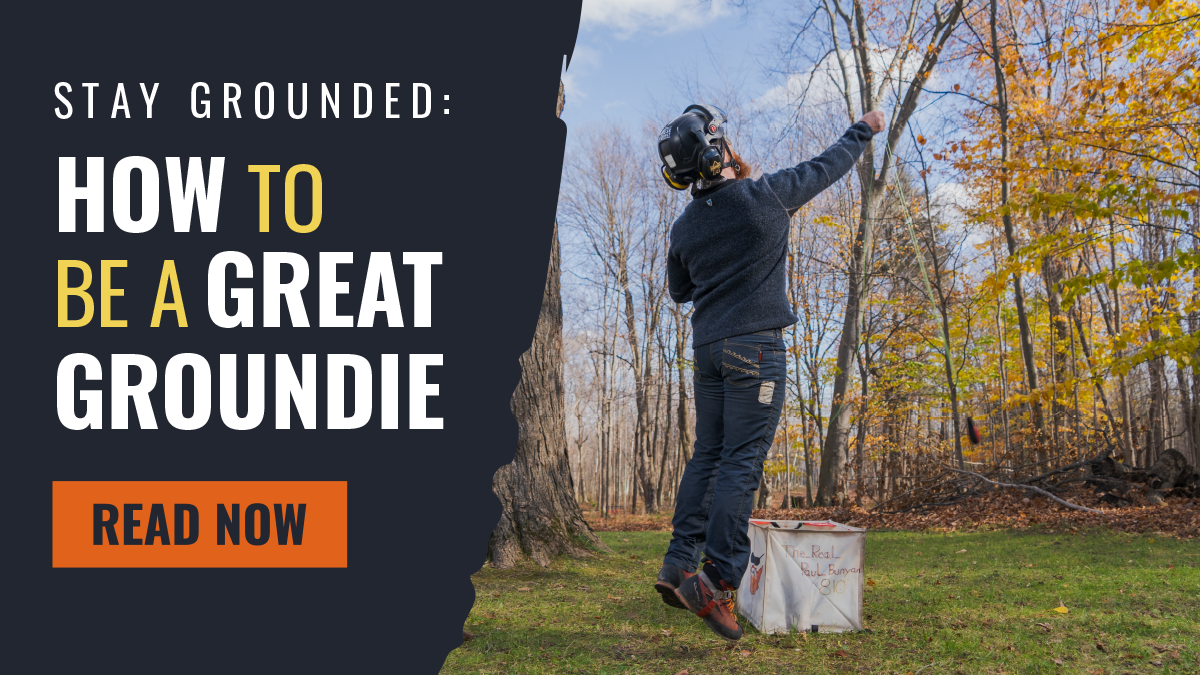
Life on the Ground: The Successful Groundie in The Drop Zone!
When most individuals consider professional tree care, they often envision skilled acrobatics, or using skid-steers, cranes, and other specialized equipment. Despite their critical role, the professional ground crew often seems to be overlooked. However, without their contributions, the workload significantly increases for everyone, including tree climbers. This blog aims to honor professional grounding and offer insights on how to handle tree limbs successfully in the drop zone.

Managing Branches
Removal operations and certain specialty jobs will require rigging, which means someone will have to run ropes on the ground. Even if you have experience running ropes, there may be situations where you are not assigned this task. This should be viewed as an opportunity for learning rather than a negative reflection. Reasons could include the tree climber aloft using a new piece of rigging equipment, having more experience with another person and therefore stronger trust, or demonstrating a new technique that requires different skills.
If this situation occurs, you will need to ensure the correct orientation of the tree limb into the drop zone once it is safe to enter and establish an efficient entrance and exit route for dragging the brush. When the tree limb falls butt-heavy, it is easier to maneuver, but when the limb falls brush-heavy, it can become quite cumbersome. To simplify this process, before the limb completely settles on the ground, an experienced rope handler will suspend the limb a few inches above the ground. Once you receive the all-clear to enter the drop zone, grab the limb by the tips and move the brush end opposite the exit path. This keeps the cut end facing the exit and it is easier to drag out as a whole to the chipper.
For larger pieces, you may have to maneuver the tree limb in a couple of steps; maneuvering the brush will remain the same, however, larger pieces will require you and the rope handler to work together, as you pull the rope handler must also lower the limb. In certain situations, the brush may prevent the cut end from remaining steady and may require manipulation by physically pushing the cut end towards the desired path; the limb must still be suspended by the rope and should be in the “power zone” to prevent straining the body. Communication with the rope handler is important here, as well.
These small steps are critical to keep the operation running efficiently. When the tree limb is laid down sloppily, the “work smarter and not harder” saying is completely thrown out the window. Think about it, if the piece is laid with the brush facing the exit route, the limb cannot be dragged out as a whole and must now require a halt of operations to cut the limb so it can be spun around (in tight rigging spaces). Tedious rigging may require the constant use of two individual rigging ropes, and you are more than likely to come off the bench and handle the second rope. Listen closely to instructions; when you are informed that you are holding onto a tag line that will only be used to pull a tree top or a log over and the piece has gained the necessary momentum, LET GO OF THE ROPE! As the tree section comes over, the rope may entangle on the way down, and when the piece hits the ground, it can pull the rope violently. If you are holding the rope, it can result in an injury, which I have seen firsthand!
Keep a constant flow of dragging brush out and if there are multiple groundies on sight, “chip and switch”. The chip and switch will ensure both ground crew members are dragging the brush and prevent them from only staying at the chipper working the down pressure lever, it also means the chipper is not left unattended while chipping. As the chipper devours limbs, debris may begin to accumulate by the hopper, take a moment to quickly scoop the larger bit of debris and either feed it into the chipper or toss it into the dump box. This can prevent a slip, trip, or a fall.
As the job nears its end, let the raking commence! Don’t be the guy who grabs the leaf blower to pile up debris. Raking can make one irate, especially when raking Sycamore or Honey Locust; it’s hard work, but it must get done. Rather than making a giant pile of sticks, make a couple piles of sticks that are easy to load onto a tarp, wheelbarrow, trash can, etc. Whatever you do, make sure you have gloves on if you decide to manhandle these stick piles; for some of the yards worked in, will be littered with dog feces – also from experience!
Tips for Standing Out
-
Be proactive: Anticipate what tools or ropes will be required before being asked.
-
Stay organized: Keep work areas tidy, equipment clean, and brush neatly stacked.
-
Ask questions: Show a willingness to learn by engaging with experienced crew members.
-
Show initiative: Take on challenging tasks to demonstrate reliability and work ethic. Avoid the phrase “I don’t get paid to do that”, that alone has the ability to tank your career! How can anyone expect to progress or have someone take the time to train them with that mentality? With that in the open, people will be hesitant to expend their knowledge on someone who potentially does not care.
-
Communicate clearly: maintain clear and consistent communication.
To be a successful groundie, commit to learning, prioritize safety, and strive to excel. A skilled groundie can be a highly valued team member even if climbing is not in the cards!



Leave a comment